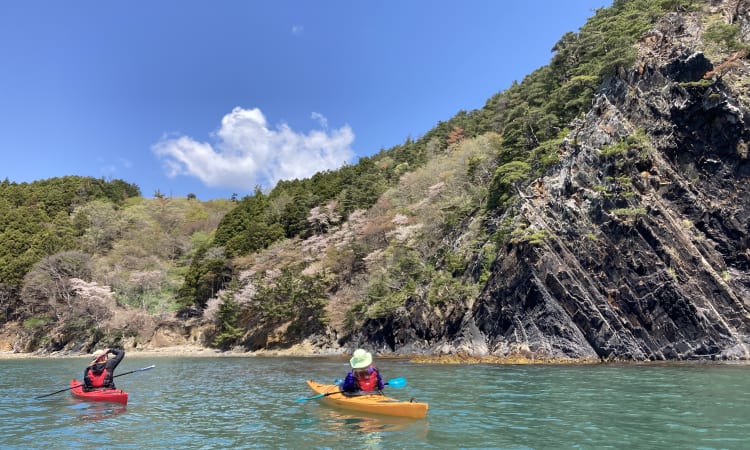
ITINERARY
Experience nature’s bounty along the Sanriku Coast through camping, sea kayaking and long-trail hiking

Tags
The Sanriku Fukko (reconstruction) National Park was created after the devastation caused by the Great East Japan Earthquake and Tsunami of March 2011, as a way to revitalize the region and showcase its natural splendor. Take a rental car to explore the region and its natural heritage, and see how communities are recovering from the 2011 earthquake and tsunami. Camp, kayak, and hike cliff tops along the way.
Itinerary Highlights
- Sea kayaking around the Oshika Peninsula
- Michinoku Coastal Trail・Experience history on the Hamakaido Route
- Learning about the geological features of the Goishi Coast
Explore the Oshika Peninsula
Start your adventure in Sendai, Miyagi Prefecture, by picking up a rental car from near Sendai Station. The Ishinomaki Area Tourism Promotion Organization rents campervans for exploring the Oshika Peninsula, as well as everything you need for camping such as tents and BBQ equipment.
From Sendai City, drive about an hour north to Ishinomaki, a fishing port that was severely impacted by the earthquake and tsunami. See the local community’s recovery efforts at Ishinomaki Genki Ichiba, a daily market that sells fresh seafood and local products, and enjoy lunch on the second floor with views of the Kitakami River.
Travel about an hour southeast to the Oshika Peninsula for a half-day sea kayaking tour. This family-friendly tour allows you to explore the waters around the peninsula. It includes breaks for refreshment on the shore, as well as walks along part of the Michinoku Coastal Trail.
Later, drive to Oshika Gobansho Park at the southern tip of the Oshika Peninsula and take in sea views from its observation deck. Less than five minutes away is the Oshika Family Travel Village Auto Camping Ground where you can stay overnight in a tent or a cabin.
Travel along the Michinoku Coastal Trail
Drive north for about an hour-and-a-half to start your exploration of the Michinoku Coastal Trail. The approximately 1,000 km trail runs from Fukushima to Aomori and was developed as a symbol of the Tohoku region’s recovery after the Great East Japan Earthquake. Join a walking tour along a section of the old Kesenmichi Road that ran the length of the historical Sendai Domain (present-day Miyagi and southern Iwate) to learn about the area’s natural and cultural history. The tour meets at Minami Sanriku Hotel Kanyo and is operated by the Okinakura Experience Explorer Leaders (OEELs). The group arranges a range of activities in the area from sea kayaking, and stand-up paddleboarding (SUP) to snorkeling and nature walks.
Lunch is at Minamisanriku Sun Sun Shopping Village. This shopping plaza started as a collection of temporary stores in the aftermath of the devastating earthquake and tsunami, which destroyed nearly 95% of the town of Minamisanriku. It is now a permanent complex with 28 stores.
Drive north and spend the night at your accommodation in Ofunato City, Iwate Prefecture. On the way, you can make a detour to visit Oshima Island, where an observation deck at the top of Mount Kameyama offers sweeping views of the surrounding bay.
Geoparks and miracle trees
From the camping ground, you can walk to the Goishi Coast Rest House, which is the meeting point for a walking tour in the Sanriku Geopark, which stretches from Miyagi to Aomori. This is the largest geopark in Japan and is known for its pebble beach, jagged coastlines, and dramatic rock formations. Learn about its geological features and how they were formed on this 90-minute guided tour.
After the tour, travel inland to Rikuzentakata, a city in Iwate that was heavily damaged by the 2011 earthquake and tsunami. The Miracle Pine Tree was the lone surviving tree of the Takata Pine Forest after the tsunami, and became a symbol of hope for the community. Unfortunately, the tree later died due to its exposure to saltwater, but it has been preserved in a full-scale reconstruction. Seeds from the miracle tree have been planted nearby, to regrow the forest.
Have lunch at Rikuzentakata Fermentation Park CAMOCY. Similar to the Minamisanriku Sun Sun Shopping Village, this is a collection of stores and restaurants that was established in the aftermath of the 2011 disaster.
Once you have finished exploring the area, you can drive back to Sendai to return the car, before continuing your onward journey.


















